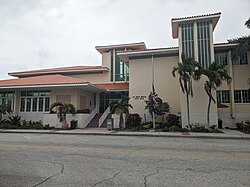St. Pete Beach, Florida | |
|---|---|
| City of St. Pete Beach | |
 St. Pete Beach city hall in 2022 | |
| Motto: The Sunset Capital of Florida | |
 Location in Pinellas County and the state of Florida | |
| Coordinates: 27°43′29″N82°44′31″W / 27.72472°N 82.74194°W | |
| Country | |
| State | |
| County | Pinellas |
| Incorporated (City of St. Petersburg Beach) | 1957 |
| Incorporated (City of St. Pete Beach) | March 9, 1994 |
| Government | |
| • Type | Commission–Manager |
| • Mayor | Adrian Petrila [1] |
| • Vice Mayor | Mark Grill |
| • Commissioners | Christopher Graus, Ward Friszolowski, and Chris Marone |
| • City Manager | Wayne Saunders |
| • City Clerk | Amber LaRowe |
| Area | |
• Total | 6.96 sq mi (18.04 km2) |
| • Land | 2.13 sq mi (5.51 km2) |
| • Water | 4.84 sq mi (12.53 km2) |
| Elevation | 6 ft (2 m) |
| Population (2020) | |
• Total | 8,879 |
| • Density | 4,176.39/sq mi (1,612.32/km2) |
| Time zone | UTC-5 (Eastern (EST)) |
| • Summer (DST) | UTC-4 (EDT) |
| ZIP Code | 33706 |
| Area code | 727 |
| Sales Tax | 7% [3] |
| Property Tax | 3.1500 City (17.0318 Total) [4] |
| Website | www |
St. Pete Beach (formerly known as St. Petersburg Beach until 1994) is a coastal city in Pinellas County, Florida. Known as a tourist destination, St. Pete Beach was formed from the towns of Pass-a-Grille, Belle Vista, St. Petersburg Beach, and unincorporated Pinellas County. It is part of the Tampa Bay area. The population was 8,879 at the 2020 census.
Contents
- History
- Geography
- Demographics
- 2010 and 2020 census
- 2000 census
- Education
- Library
- Tourism
- Notable people
- References
- External links
St. Pete Beach's downtown is centered on Corey Avenue. This district contains bars, restaurants and shopping and retail outlets. [5] [6] [7] The Pass-a-Grille Historic District and the historic Don CeSar beach resort are located at the southern end of the beach.

